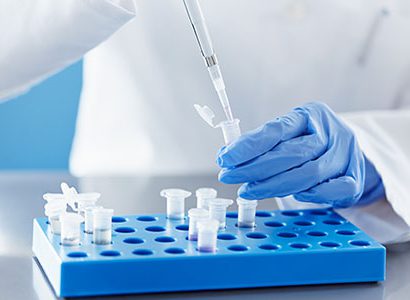PFAS and Breastfeeding

Breastfeeding is the best source of nutrition for most infants.

The broad and compelling advantages of breastfeeding for infants and mothers have been documented with extensive research. Breastfeeding is beneficial for the health of infants and mothers. Some of the many benefits for infants include a reduced risk of ear and respiratory infections, asthma, obesity, and sudden infant death syndrome (SIDS).
Breastfeeding can also help lower a mother’s risk of high blood pressure, type 2 diabetes, and ovarian and breast cancer.1 The American Academy of Pediatrics (AAP) and the Dietary Guidelines for Americans, 2020-2025, both recommend exclusive breastfeeding for about 6 months, and continuation of breastfeeding, with the introduction of complementary foods, for 1 year or longer as mutually desired by mother and infant.1, 2
Do PFAS enter breast milk?
Multiple factors play a role in the personal decision to breastfeed an infant. The potential for exposing an infant to environmental chemicals, including per- and polyfluoroalkyl substances (PFAS), through breast milk is one of the many factors that mothers and their families may consider. PFAS are widely dispersed and ubiquitous in the environment, and most people in the United States and other industrialized countries have measurable amounts of PFAS in their blood. Research studies have shown that PFAS can be found in human breast milk and excreted through lactation.3 The mechanism by which PFAS enter breast milk is not yet fully understood. The level of exposure to an infant depends on a number of circumstances, some of which include the level of PFAS in the mother, the amount of PFAS that transfers to her breast milk, and the duration of breastfeeding.
Should I have breast milk tested for PFAS?

Significant developments in laboratory analytical methods now allow for the detection and measurement of small amounts of PFAS in human breast milk. However, measuring PFAS in breast milk is not a routine test performed by most commercial laboratories. The composition of breast milk is complex, and factors that influence the concentration of PFAS in breast milk are not completely understood. Some studies show that levels of PFAS may vary depending on the time of breast milk collection during a single feed or throughout the course of lactation.3, 4 Methods of breast milk sample collection, storage, and shipping must be performed in a way that minimizes or eliminates the possibility of contamination.4, 5 Testing requires a standard, validated method for detection, extraction, and analysis, as well as quality control methods for human milk. PFAS levels measured in breast milk are most helpful when performed as part of a carefully designed research study.
To date, there have not been large-scale biomonitoring studies for PFAS in breast milk to establish reference values for comparison that are representative of the population of breastfeeding women in the United States. Reference values allow physicians and scientists to determine whether a person or group has an unusually high exposure. Further, there is no established PFAS level for breast milk at which a health risk for an infant (or mother) is expected. Without this information, it is difficult to interpret test results.
Some additional limitations with interpreting test results include
- Even with the ability to confirm the presence of PFAS in breast milk, it may be difficult to estimate how much PFAS an infant is absorbing (bioavailability).
- PFAS levels in breast milk cannot determine if exposure is associated with past or present illness and cannot predict future (short or long term) illness or adverse health effects in the infant or the mother.
- Infants can also be exposed to PFAS during pregnancy and from other sources in their environment, making it extremely difficult to determine if or how much of an infant’s body burden of PFAS is contributed from breast milk.
Should I continue to breastfeed?

For the general population, ingestion of PFAS is considered the major human exposure pathway. For populations with PFAS in their drinking water supplies, drinking water exposure is an important contributor to PFAS exposure. For infants, breast milk can be a source of PFAS exposure. Even though PFAS have been detected in breast milk, studies have not shown a causal relationship with a specific health effect in infants or children.6 In addition, an infant could be exposed to other environmental chemicals, besides PFAS, through breast milk, making it difficult to associate any potential health affect to one chemical or class of chemicals.
With numerous protective health benefits, breast milk continues to be the ideal nutrition for infants, and in nearly every circumstance, the Centers for Disease Control and Prevention and the American Academy of Pediatrics recommend that nursing mothers continue to breastfeed their babies despite the potential presence of environmental contaminants.⁷
There are circumstances in which an infant may not be able to breastfeed. In this case, if powdered or concentrated liquid formulas are used, they should be mixed with water from a safe source. In addition, it’s important for everyone, including nursing mothers and women of reproductive age, to take steps to reduce or eliminate sources of PFAS exposure (e.g., certain foods and food packaging, contaminated drinking water, and stain-repellant and water-repellant materials).
The science on the health risks of PFAS exposure is evolving. However, given the scientific understanding at this time, the benefits of breastfeeding outweigh any potential risks of PFAS exposure through breast milk. In addition to regular prenatal care, nursing mothers should continue to receive recommended routine post-natal care and are encouraged to engage in discussions with their healthcare provider when questions or concerns arise. Infants and children should also receive regular well-child checkups, recommended vaccinations, and health screening tests appropriate for age.
Consultation with a specialist in occupational and environmental medicine, or others with expertise and experience treating patients exposed to PFAS, may help guide primary healthcare providers with development of a periodic monitoring plan, as appropriate.
A woman’s decision to breastfeed is a personal choice, often made in consultation with her healthcare provider. It is a choice made after the consideration of many different factors specific to the mother and child. ATSDR has developed information on PFAS to guide clinicians and aid in this decision-making process.8
Additional resources about PFAS and breastfeeding
For additional resources and assistance in answering questions about PFAS exposure and breastfeeding, please contact
- The Centers for Disease Control and Prevention / Agency for Toxic Substances and Disease Registry (ATSDR) at CDC-INFO, or call (800) 232-4636.
- The Pediatric Environmental Health Specialty Units (PEHSU) — a network of experts specializing in the impacts of environmental factors on the health of children and reproductive-age adults. To find an expert in your area, please visit Find PEHSU Experts.
- The Association of Occupational and Environmental Clinics (AOEC) — a network of clinics committed to improving the practice of occupational and environmental medicine. To find a clinic in your area, please visit AOEC Clinic Directory.
References:
- American Academy of Pediatrics, Section on Breastfeeding: Policy Statement. Breastfeeding and the use of human milk. Pediatrics. 2012;129(3):e827-e841. https://doi.org/10.1542/peds.2011-3552
- S. Department of Agriculture and U.S. Department of Health and Human Services. Dietary Guidelines for Americans, 2020-2025. 9th Edition. December 2020. https://www.dietaryguidelines.gov/
- Macheka-Tendenguwo, L.R., Olowoyo, J.O., Mugivhisa, L.L. et al. Per- and polyfluoroalkyl substances in human breast milk and current analytical methods. Environ Sci Pollut Res 25, 36064–36086 (2018). https://doi.org/10.1007/s11356-018-3483-z
- S. Alcala, J.S. C. Basilio, I. White, S.A. Marchiti, E.P. Hines, C.M. Berlin, S.E. Fenton, Environmental Chemicals in Breast Milk, Editor(s): J.O. Nriagu, Encyclopedia of Environmental Health 2nd Edition, Elsevier, 2019, Pages 392-407
- Suzanne E. Fenton, Marian Condon, Adrienne S. Ettinger, Judy S. LaKind, Ann Mason, Melissa McDiarmid, Zhengmin Qian & Sherry G. Selevan (2005) Collection and Use of Exposure Data from Human Milk Biomonitoring in the United States, Journal of Toxicology and Environmental Health, Part A, 68:20, 1691-1712, DOI: 1080/15287390500225708
- LaKind, J., Lehmann, G., Davis, M., Hines, E., Marchitti, S., Alcala, C., Lorber, M., 2018. Infant dietary exposures to environmental chemicals and infant/child health: A critical assessment of the literature. Environmental Health Perspectives 126 (9), 96002. https://doi.org/10.1289/EHP1954
- American Academy of Pediatrics, Council on Environmental Health. Breast Milk. In: Etzel, RA, ed. Pediatric Environmental Health, 4th Edition; Itasca, IL: American Academy of Pediatrics; 2019: P. 238
- Agency for Toxic Substances and Disease Registry. (2019). PFAS: An Overview of the Science and Guidance for Clinicians on Per- and Polyfluoroalkyl Substances (PFAS). https://www.atsdr.cdc.gov/pfas/docs/clinical-guidance-12-20-2019.pdf
More information on breastfeeding is available at
- Agency for Toxic Substances and Disease Registry (ATSDR): Per- and Polyfluoroalkyl Substances (PFAS) and Your Health. PFAS chemical exposure | ATSDR (cdc.gov)
- Centers for Disease Control and Prevention (CDC): Breastfeeding – Why It Matters.
- Centers for Disease Control and Prevention (CDC): Breastfeeding and Special Circumstances, Environmental Exposures / Toxicants.
- U.S. Department of Health and Human Services, Office on Women’s Health: Breastfeeding – Making the decision to breastfeed.
- American Academy of Pediatrics, healthychildren.org: Breastfeeding.